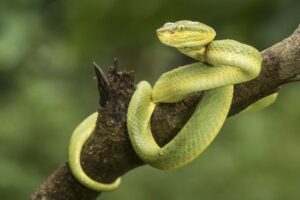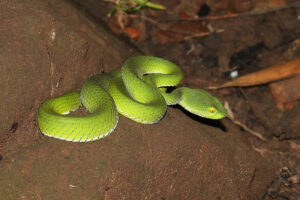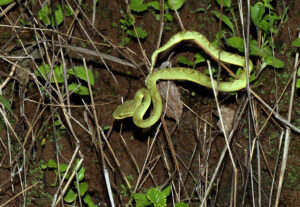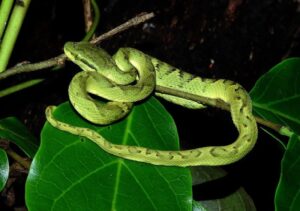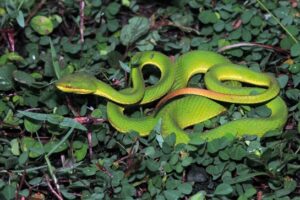Bamboo pit vipers are venomous vipers found in southern and northeastern India. They are the most widespread pit viper in the country and the only ones inhabiting the dense forests of the Peninsular Plateau of India.
These snakes are also referred to as bamboo snakes, the Indian tree vipers, the Indian green pit vipers, and the common green pit vipers.
They are called pit vipers because they have heat-sensing pits between their eyes and nostrils on both sides of their head.
They are solitary, arboreal, nocturnal, and slow-moving snakes. When threatened, they vibrate their tail and strike very fast. This species was first described as Coluber graminaeus in 1802.
Scientific Classifications
- Suborder:Serpentes
- Family:Viperidae
- Genus:Craspedocephalus
- Species:C. gramineus
Conservation Status
Subspecies
Bamboo pit vipers have two subspecies:
- Chen’s Pit Viper (T. s. chenbihuii)
- Stejneger’s Pit Viper (T. s. stejnegeri)
Description
Size
They can grow up to 39 inches (99 cm). The length of their tail is 5.5 inches (14 cm).
Color and Appearance
Bamboo pit vipers have small and light bodies. Their upper parts are mainly green, but in some rare specimens, it is yellowish, greyish, or purple-brownish. Sometimes they have black, brown, or reddish spots. Their lower parts are creamish yellow to dirty white. The outer row of their scales has a light, white, yellow, or red streak.
They have 21 longitudinal rows of dorsal scales in the middle of the body. There are 150-174 ventrals and 54-77 pairs of subcaudals. Their supraoculars are single, narrow, and sometimes divided by a traverse suture. They have 9-11 upper labials, the first separated from nasal scales by a distinct suture.
Their eyes are red with vertical pupils. They possess retractable fangs that can inject venom deeply into the human body. Their most distinguishing feature is their heat-sensing pits between their eyes and nostril.
Are They Dangerous to Humans
These snakes have neurotoxic and hemotoxic venom, which are harmful to humans. Though not naturally aggressive, they do not hesitate to bite if harassed. They do not always release venom when they bite, but it becomes excruciating if they do.
The envenomation is very painful, lasting about 24 hours after being bitten. The sensation is like being branded with a hot iron. The site of the wound swells and turns black due to necrosis. Fatalities caused by their bite are rare, but they can occur.
Bamboo Pit Viper at a Glance
Distribution
Bamboo pit vipers mainly occur in southern India, covering much of the state of Tamil Nadu. They are also seen near Harishchandragad and some other mountain ranges of the Western Ghats. In eastern regions of India, they are scarcely found in Odisha, Jharkhand, and West Bengal.
Habitat
These vipers live in bamboo groves and forests, mostly near streams. They also reside in dry scrub forests.
Predators
Large mammals and birds like peregrine falcons feed on bamboo pit vipers.
Diet
The diet of bamboo pit vipers includes birds, frogs, lizards, and small rodents.
These snakes use their pit organs to track their prey. They inject their venom into the prey through their hollow fangs. The effect of the venom is not immediate. The poison spreads across the prey’s body, and eventually, the animal collapses. After the animal dies, the pit viper engulfs the prey.
Reproduction
Ovoviviparous in nature, their eggs are incubated inside the mother, who gives live birth to snakelets. They can give birth to 6-11 young ones in one litter. The newborns are 4.5 inches long.
Similar Species
Greater Green Snake
These non-venomous snakes look a lot like bamboo pit vipers. The shape of the head and eyes can distinguish the two. The head of greater green snakes is small, while that of bamboo pit vipers is big. Greater green snakes have golden eyes with round pupils, whereas bamboo pit vipers have red eyes with vertical pupils.
Malabar Pit Viper
Found in the Western Ghats, these snakes are famous for their ability to change body colors. They have triangular heads, whereas bamboo pit vipers have a trilateral head.
Green Keelback
These are non-venomous snakes found in the Indian subcontinent. Like bamboo pit vipers, they have bright green dorsal color.
rahulalvares.com, projectnoah.org, flickr.com, linodeobjects.com, twitter.com

